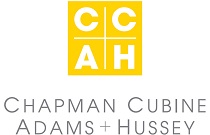
8 Tips on Integrated Fundraising from the 2014 Bridge Conference
This article was written by guest authors, Mark Johnston, Senior Advisor, hjc and Jessica Lewis, Fundraising Innovation Consultant, hjc.
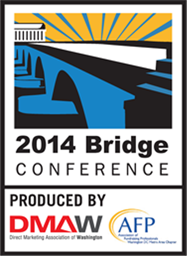 The Bridge Conference always delivers with great sessions for nonprofits and is jam packed with lots of knowledge you can take back and apply in all aspects of your fundraising work. This year’s conference was no exception. Here are some of the valuable tidbits that we garnered from the sessions hjc attended last week at Bridge that you may find helpful as you tackle your integrated fundraising programs.
The Bridge Conference always delivers with great sessions for nonprofits and is jam packed with lots of knowledge you can take back and apply in all aspects of your fundraising work. This year’s conference was no exception. Here are some of the valuable tidbits that we garnered from the sessions hjc attended last week at Bridge that you may find helpful as you tackle your integrated fundraising programs.
- The need for responsive design – You need to be able to reach the donor through the channel to which they are connected, so it’s important to know where they are most engaged. For example, mobile usage online overtook desktop use for the first time in 2014. If you have a limited budget, then start making sure that your forms (e.g. donation forms and sign ups) are mobile responsive.
- Personalization matters – We can all benefit from fine-tuning our communication strategies so that the donor experience is personalized. No matter where people click through to you, have a plan mapped out that will make the donor journey matter on a personal level to the donor. Make sure to integrate the donor’s information throughout your campaign.
- Measure impact – Steve Nardizzi, the CEO of Wounded Warrior Project, at his keynote address argued that charities need to do a better job of measuring impact (for example, Wounded Warrior Project publishes their ratios on their website). He also advocated for charity ratings to be based on a wider concept of impact, the importance of the charity’s mission as well as their long term plans. He asserted that organizations such as Charity Watch and Charity Navigator use criteria that are too narrow through which to rate a charity (e.g. fundraising ratios) and that a broader set of criteria needs to be applied to pass judgement on charities and measure how they are achieving their missions and mandates over the long term.
- Communicate to your donors in their preferred channel – Connected to the idea of personalization, being able to identify and push communication to the donor in their favourite channel is key to improving results in the long run.
- Invest in SEM – Investing in Search Engine Marketing has been proving to be successful for a number of nonprofits. If you have a limited budget, then investing in your year-end campaign may be a strategic use of limited marketing dollars. And this is all on top of your Google Grant!
- Test, test, test! – Don’t be afraid to test everything – from email send time to donation ask amounts to preview pane copy! This will help you better understand your list and build your integrated fundraising program as a result.
- Make it easy for your donor – It pays off to closely examine and make sure that you don’t have any extra steps on your donation form that will lengthen the time it takes to donate. The same goes for your peer to peer event registration forms.
- Pick only what works for your organization! – Remember, everyone’s needs for solutions and strategies are unique to each nonprofit’s reality! Examine all of the angles of potential strategies before you leap into them.
Montgomery Area Food Bank Puts a Young Spin on an Old Program
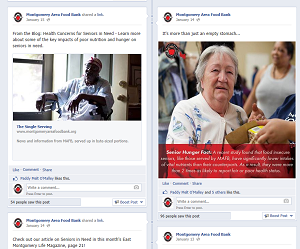 The Montgomery Area Food Bank (MAFB), a nonprofit organization serving senior citizens in Alabama, recently put a “young” spin on an “old” program – and found gold: The MAFB was recognized with a 2014 IMAB Integrated Marketing Award.
The Montgomery Area Food Bank (MAFB), a nonprofit organization serving senior citizens in Alabama, recently put a “young” spin on an “old” program – and found gold: The MAFB was recognized with a 2014 IMAB Integrated Marketing Award.
The MAFB improves the lives of more than 330,000 people every year, providing free food to individuals and families in need by distributing groceries and other necessities, and partnering with more than 800 agencies. The Senior Supplement Program, one of MAFB’s many life-changing services, provides nourishing food to elderly citizens across Alabama. Each month, all participating seniors receive a box filled with 25 to 35 pounds of nutritious food carefully selected for the special needs of older citizens.
But at one point, this relied-up service was in jeopardy – the Senior Supplement program had been struggling, and with funding so low, any hopes of program expansion were put on hold indefinitely – MAFB has not been able to add any new seniors to the program in over a year.
Finding Gold in Something Old
The MAFB realized they had to make a change to achieve their goals of increased engagement and overall support for the Senior Supplement Program. In their new strategy, MAFB switched the focus of their marketing, to call attention to the program itself and allow supporters to get to know the seniors they serve. The MAFB did this by sharing personal stories from participants, a smart way to educate donors on how the Senior Supplement Program profoundly improves the lives of seniors in need. The MAFB also began showing program-specific donors results to acknowledge the impact of their gifts and foster an emotional connection between the donor and the seniors.
To share their stories and increase awareness of the Senior Supplement Program, the MAFB switched to social media. Typically known for its influence on a younger audience, the MAFB opted to use social media channels to put a young spin on an old program, with hopes of reaching new followers and growing support. Staff dedicated one month to using Facebook, Twitter, and the MAFB blog to promote stories, facts and information about the seniors they serve. On Facebook, MAFB posted compelling images with facts summarizing the serious health concerns facing seniors who are malnourished. On their blog, the MAFB posted persuasive stories, one of which was written about an 81-year-old woman whose medical conditions did not allow her to digest solid foods.
The social media strategy was complemented by a matching grant opportunity: all first-time donors or donors who increase their giving (by dedicating gifts to the Senior Supplement Program) had their donations matched with a $10,000 gift.
One Donor ‘Ensures’ Program Continues
The results of this “young” strategy proved very rewarding for the program. In response to the story about the elderly woman who can’t digest solids, the program received donations of Ensure meal replacement drinks. The MAFB also received monthly sustainer donations in response to the same story.
In addition to expanding their social reach, the MAFB saw increases in overall visitors to their website and click-throughs driven from social media posts. In June of 2014, the Senior Supplement program increased the number of participants served by 6%, and this growth is forecasted to continue. On social media, the MAFB saw a 5.6% increase in Facebook likes, and an impressive 33% increase in Twitter followers in May and June of this year.
Last, but perhaps the most meaningful, the organization saw growth in their monthly recurring donations, adding 7 new monthly donors in 2014, two of which contribute directly to the Senior Supplement program.
The MAFB showed that social media is a powerful platform and useful for integrated campaigns when part of a strategy. These initiatives proved that knowledge is power – when supporters know more about the program’s depth and true impact of their gift, they develop a stronger connection to the organization’s mission and are more likely to stay engaged and give again. And while the Senior Supplement Program caters to older citizens, it is in fact, young at heart.
Share, Like and Post | | Article Link | CommentShow Me the (Online) Money!
This article was written by guest author Alexa Langford, Manager of Research & Analytics, Grizzard.
We know that today’s donors are living in a multi-channel world, with ever-increasing ways to give. Many of these new solicitation channels end up with the actual donation taking place on the organization’s website, and are considered online gifts. And according to Grizzard’s 2014 DonorGraphics™ survey, 31% of donors prefer making charitable donations online, eclipsing mail (preferred by 26%) for the first time ever.
And so, many organizations now understand that synchronizing the messaging on their website with online and offline communications is a key way to increase revenue. If a donor receives a matching gift appeal in the mail, then goes online to donate and sees the same matching gift message in a homepage bug, their experience is more connected and uniform. These types of coordinated campaigns helped nonprofits grow online revenue 13.5% in 2013 (source: Blackbaud 2013 Charitable Giving Report).
While it is expected that online giving will continue to climb for nonprofits, many nonprofits are still understandably skeptical about the relationship between direct mail and online giving. It’s easy to say that direct mail contributes to online giving, but harder to prove.
One of Grizzard's clients in the human services vertical, currently synchronizing their marketing efforts with us, recently challenged us to clearly demonstrate the link between online giving and offline solicitations. We identified a 6 month window (October 2013 through March 2014) to ensure that both holiday and non-holiday periods were included. We then analyzed all online and white mail giving during this time period, matching it back to both renewal and acquisition solicitations (which were coordinated with their website and online messaging). Only gifts preceded by a solicitation were included. Our results:
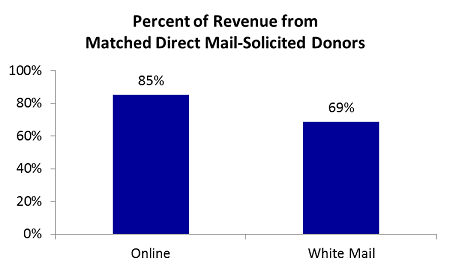
Our results show that 85% of online revenue and 69% of white mail revenue could be tracked back to donors who were solicited through direct mail prior to their donation. In this case, we were able to show this client the money -- over $250,000 -- that had been raised through their cohesive and coordinated messaging.
Is your website optimized for online giving? Are you coordinating your online and offline messaging? Let us know what you’re doing to synchronize your fundraising in the comments section below.
Share, Like and Post | | Article Link | CommentDelivering the Right Constituent Experience for Your Nonprofit Through Omnichannel Marketing
 At 38, I’m a veritable young’un professionally speaking. But the change I’ve seen in nonprofit integrated fundraising and marketing over the last thirteen years is tremendous. When I started in this business as a walk manager, my call to action and path to success were very clear: Recruit walkers for AIDS Walk Pittsburgh, help them fundraise door-to-door, and host a memorable Walk. I was an event coordinator before peer-to-peer online fundraising really took off, before most nonprofits cared about an e-newsletter and before Google started Grant-ing.
At 38, I’m a veritable young’un professionally speaking. But the change I’ve seen in nonprofit integrated fundraising and marketing over the last thirteen years is tremendous. When I started in this business as a walk manager, my call to action and path to success were very clear: Recruit walkers for AIDS Walk Pittsburgh, help them fundraise door-to-door, and host a memorable Walk. I was an event coordinator before peer-to-peer online fundraising really took off, before most nonprofits cared about an e-newsletter and before Google started Grant-ing.
Then, the era of Digital Darwinism began, upending how nonprofits and commercial companies alike approach building consumer experience. The proliferation of digitally-driven “big data” has landed us in the overwhelming world of what’s sometimes now being called “omnichannel” marketing. While the term might be considered the latest industry buzz word, the concept is right-on.
As our media landscape has grown and our consumer experience over digital channels and devices has evolved, so has the requirement of marketing.
- Omnichannel marketing is NOT mirroring your direct mail program in your email program.
- Omnichannel marketing is NOT using the same brandmark and creative treatment in every channel.
- Omnichannel marketing is NOT making sure you get physical addresses, email addresses and social credentials for all of your constituents.
So what is omnichannel marketing?
Quite simply, omnichannel marketing is an approach which should deliver a consumer’s desired experience with your organization. It is the mechanism for creating a continuous experience that recognizes how, where and why your constituents interact with you. Omnichannel marketing requires that a consumer’s behavior in one channel or program should influence his experience in others.
Where the complicated, tangled hairball comes in is managing the complexities born of the drivers of an individual’s desired experience. Drivers come in two categories:
Cultural Drivers
These are the drivers that make me expect you to send me a mobile optimized email, to reach me on Facebook with shareable content, to show me real results of what you’re doing with my money, to know I don’t care about Vine and that I never open my direct mail pieces for anything outside of the address labels which I take before throwing the rest of the package in the garbage.
These drivers can largely be decoded with persona and segmentation research.
Personal Drivers
The other category of drivers is personal. And these, I believe, comprise the key difference between nonprofits and commercial companies. Nordstrom needs to know what brands I prefer, what sizes I wear and how often I shop online—pretty easy stuff to track. But I expect the American Heart Association to know that I want heart-healthy recipes in my Go Red for Women emails and Facebook newsfeed, but that I’m not yet interested in donating. I expect Oldies But Goodies Cocker Rescue to know I’m an adopted dog mom who’s passionate about responsible pet ownership but can’t adopt another furbaby. And, I expect Ronald McDonald House Charities to know that I have given to them through workplace giving because they helped my husband and stepdaughter when she was injured, and am I prime candidate to recruit for their local 5K.
I don’t expect the nonprofits I interact with as a donor or constituent to be omniscient. I expect them to ask, and I expect them to pay attention to what I do with the content they serve me. What makes it so hard for nonprofits to do the same? One of the key differences between commercial and nonprofit businesses and their ability to be relevant is that we give commercial entities really relevant transactional information that they can use to optimize our engagement. The transactional history tells just about the whole story of our desired experience. But with nonprofits the engagement/awareness signals are less transactional, more personal, and thus slipperier. To get at them requires an unprecedented amount of coordination between business units and their budgets to create, measure and iterate the right experience for every constituent.
Collecting these drivers of desired experience at an individual level and building content strategy, segmented contact plans and budgets for what they require is no small exercise in collaboration. To help you incrementally build your constituents’ optimal omnichannel constituent experience, take it step by step:
- Identify, acquire and engage the right constituents
- Balance budgets between channels and the audiences in them
- Attribute marketing efforts across channels and collect data at the constituent level as much as possible
- Allow the trends in that data to inform a test plan that will get you closer to allowing someone’s interaction with yo in one channel or program to affect how you treat them in subsequent communications
So what successes and challenges is your nonprofit having with omnichannel marketing? Please comment below or reach out to me at bmaki@pmdigital.com
Share, Like and Post | | Article Link | CommentHow the League of Women Voters Hit a Home Run in Fundraising
This article was written by guest author Meg Mader, Account Executive, Digital Media, CDR Fundraising Group.
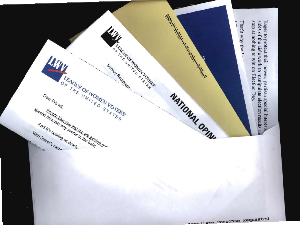 As one of the 2014 IMAB Integrated Marketing Award winners, the League of Women Voters’ 2012 emergency response campaign is one we all can admire.
As one of the 2014 IMAB Integrated Marketing Award winners, the League of Women Voters’ 2012 emergency response campaign is one we all can admire.
Prior to the 2012 elections, when United States voter ID laws began to gain momentum, thus threatening the rights of voters, the League of Women Voters quickly took action. This nonpartisan political organization, which represents more than 100,000 members, supporters, and activists, launched a fully integrated emergency appeal and acquisition campaign to take on the 2012 “War on Voters.” And they didn’t just round first base with this one — they knocked it out of the park.
This home run was a comprehensive, cross-departmental campaign that saw success in both acquisition and appeal packages, including a 127 percent lift in response rate for acquisition. It not only continues to hold steady as the organization’s new control package, but it has also grown the League’s file size by 55 percent in the three years since its inception.
Internal Integration Leads to Fundraising Integration
This crowning achievement didn’t come easily. Though the fundraising opportunity did present itself while the “War on Voters” was receiving media attention, what truly made the campaign a winner was their ability to overcome challenges between departments, instead coordinating efforts and demonstrating internal communications to help the campaign to reach its full potential.
The League’s development group worked closely with its Political and Communications departments to ensure all were involved in the progression of the campaign. The League’s development team demonstrated the benefits of such internal collaboration through donor value studies, and in the end, all groups collectively agreed to include some activist lists in the direct mail acquisition and email efforts. This proves the League’s development team worked with their colleagues to show that team work can make a campaign more successful for all who join the game — to better meet and surpass the organization’s goals with no department missing opportunities or striking out.
Winning the War on Voters
The League’s acquisition mailing included a National Opinion Survey with an ascending ask string. Overall, the package performed impressively, with a 127 percent increase over the previous control and a 1.10 percent response rate that held steady the following year. Even more notable, the package resulted in the League’s highest amount of 0–12 month donors in more than 10 years, and it shows no sign of slowing down: the package didn’t lose any steam post-election, holding a 1.60 percent response rate.
If not another home run, the appeal package slid effortlessly into third base: The response was equally inspiring, raising more than $170,000. The letter replicated an internal memo marked “urgent” from the League’s executive director to the League’s president, used a descending ask string, and mailed in an official carrier to ignite a sense of urgency in the donor. This proved successful, increasing the response rate from the anticipated 4.17 percent to a remarkable 7.59 percent.
Both direct mail efforts were complemented with corresponding email messages sent before and after each package, and a phone call the following month rounded out this integrated campaign.
And the Game Goes to … the League of Women Voters
Overall, the League of Women Voters’ fundraising program is fully integrated, incorporating email, phone calls, and telemarketing to supplement their direct mail program. The success of the League’s “War on Voters” emergency response campaign proves this organization can overcome internal challenges in the locker room to react swiftly and successfully, and hit home runs that benefit their members and supporters, and their bottom line.
Share, Like and Post | | Article Link | Comment





